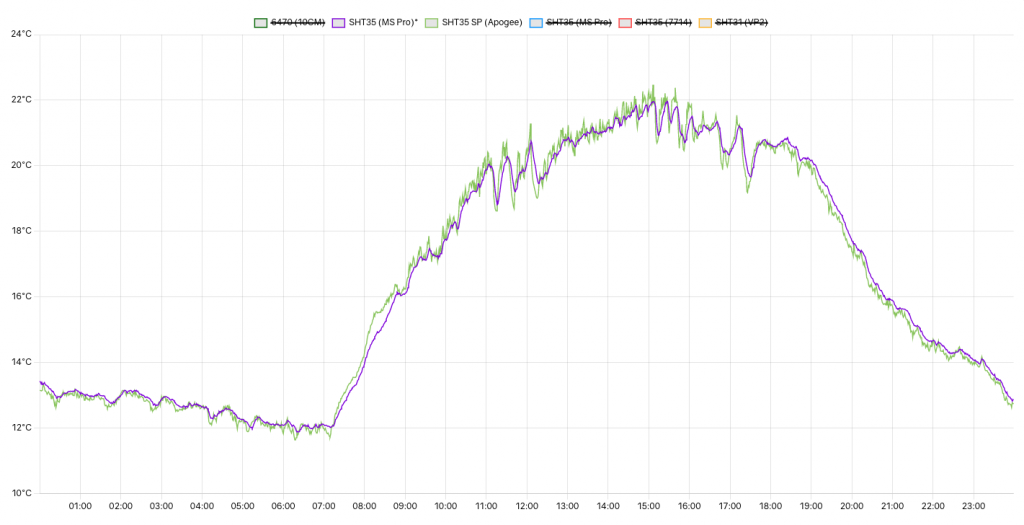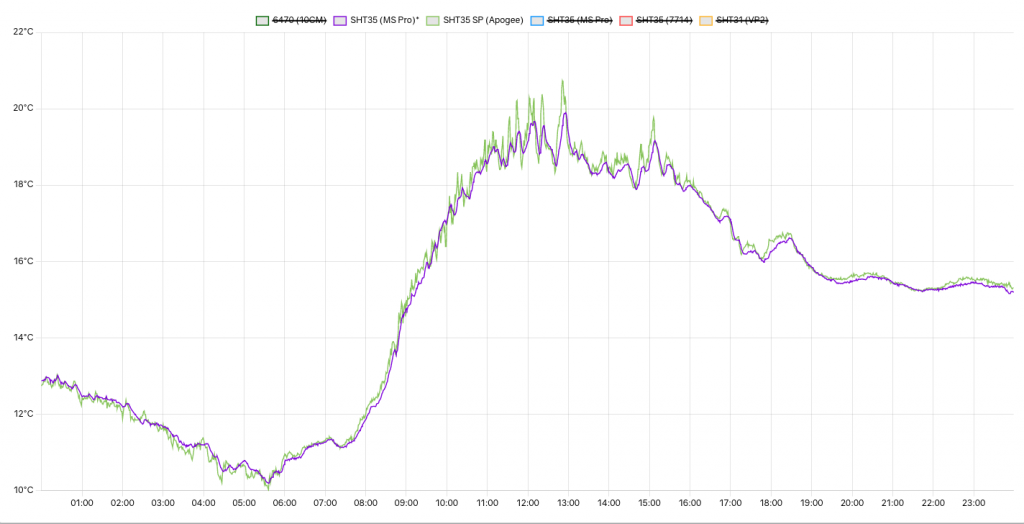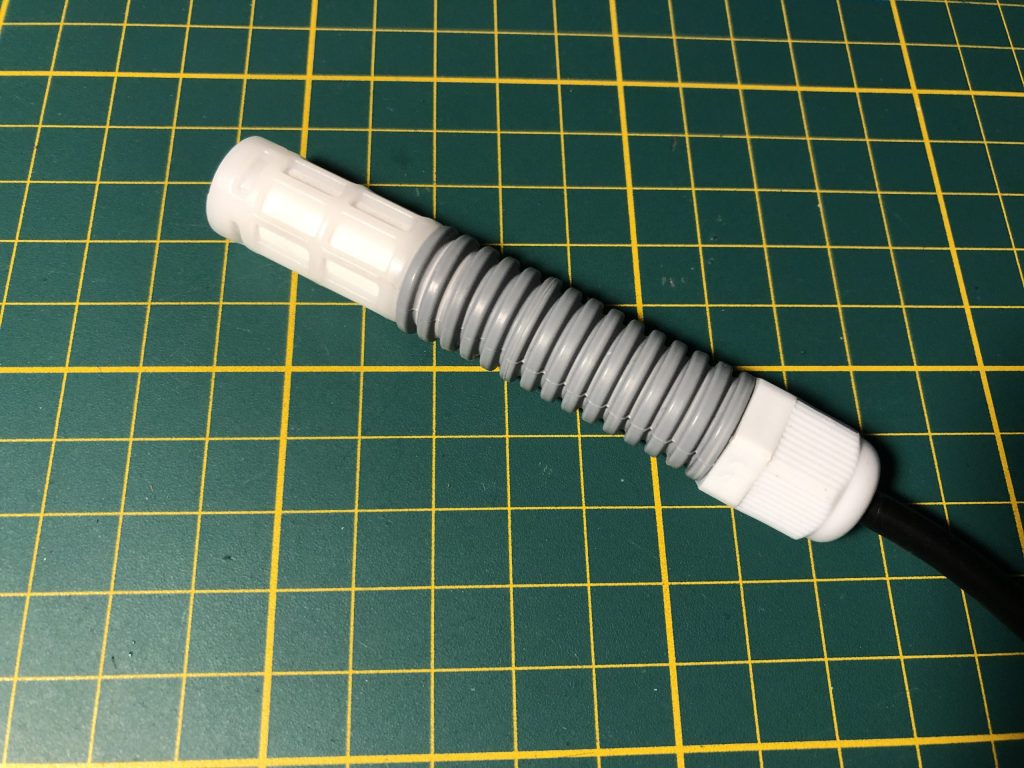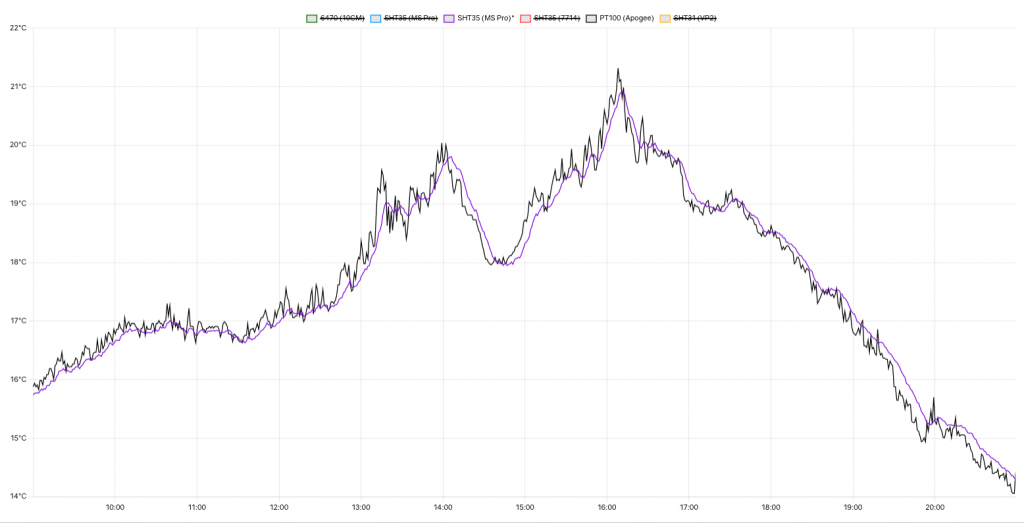I was losing the last light and had to get a flash light while connecting the last wires Tuesday evening (August 17th), but I have the TS-100 up and running. Without battery backup for now. I will fix that later.
Adding this new shield to my setup has triggered a whole series of new tests and comparisons between existing as well as new sensor and shield combinations. This blog is about (part of) that process, which leads from confusion to new insights and new sensors!
Relevant before I proceed is to know that my first and simple fan speed calculation method dictates a minimal fan speed of 50% at all times, 100% for solar radiation above 250 W/m2 and two levels (70% and 85%) in between.
The shields being compared at the start are:
- 2x Barani MeteoShield Pro with identical SHT35 sensors in plastic probe casings
- 1x Davis 7714 with an SHT35 in a steel probe
- 1x Apogee TS-100 with an SHT35 similar to the first, but from a different seller
- 1x Davis VP2 shield with an SHT31
First impressions
Time for first impressions. What was I expecting? Since a while I’ve trusted the Barani MeteoShield Pro with the SHT35 probe more and more. As listed, I have two of them with identical SHT35 probes. They are in agreement almost all the time and results match up very well on average with official KNMI readings at Hoogeveen (13 km away). Daily averages are often identical, monhtly averages within a tenth of a degree. With that in mind I expected two things.
First, that during the night the Apogee would probably read a little lower at times. This because wind often drops off entirely at sensor level after sunset, and I’ve assumed that my nighttime lows are a bit high because the passive shields might be retaining a little heat due to lack of ventilation. Looking at the following graph for 0:30 to 4:30, the Apogee (in light green) does indeed dip a bit lower.

The second expectation is that during the day, the Apogee will follow the two Barani shields closely, and perhaps remain slightly cooler during peaks in solar radiation. As it turns out, this is not what happened at all! Here are the graphs for the first day, from 12:30 to 17:30, for temperature and solar radiation.
Let me also add the graphs for the same period on the second day.
While I expected the Apogee to follow the Barani graphs (in purple and blue), it turns out the first data is a much better match with the Davis 7714 shield (in red). The 7714 is more responsive than the Barani, I have noticed that before, but it seems likely that this is due to the different probe type in stead of the shield itself. For longer periods, the Apogee and 7714 seem to agree more than the two Barani’s do!
I cannot say yet what this indicates. There are some caveats, after all. While the Barani’s have two identical probes, the other two shields do not. It is all the more striking to me how much the red and green lines match up. But it is an important factor. While I have long assumed that the 7714 must be an inferior shield, I am now contemplating the possibility that the two Barani’s, due to the shields themselves, the probes inside them, or both, actually respond poorly to changing conditions. I interpreted lack of temperature spikes during strong solar radiation as an indication of quality.
This may still be the case, of course. As I do not have 4 identical probes that will fit into all four shields, I will have to come up with a procedure to exclude some possibilities. I have several (wild) theories in mind.
Before I get into details about those, I want to change the sensor in the secondary Barani shield. That way I can exclude the possibility that it’s related to those sensor probes.
If readings turn out to be similar, I will want to use a different sensor inside the Apogee. Possibly a small thermistor. Something small, that blocks as little air flow as possible and catches as little stray radiation as possible.
The coming days should show different weather. Dry conditions with higher radiation.
Update August 21st
Today was quite ideal for testing. The day started of with foggy conditions. During the morning, the sun came out and radiation soon peaked towards 1000 W/m2. On top of that, there was hardly any wind at sensor level. Ideal conditions to test the effect of the fan. So, how did temperature readings develop?
The day started off with a similar pattern. The two Barani shields agreeing with each other, but not with the 7714 and Apogee, which showed similar readings once more. But then something new happened. See these graphs for the period between 08:00 and 13:00.
After 09:00, the pattern (Barani’s vs 7714/Apogee) started to emerge. However, around 11:00 that all changed. The sun came out, radiation started rising quickly. While the 7714 still showed higher readings, the Apogee suddenly joined the two Barani’s with roughly similar readings.
Update August 22nd
Previous results caused me to call into question the accuracy, not so much of the Barani shield, but of the two specific SHT35 sensor probes. Yesterday evening, I changed the probe in my second Barani MeteoShield Pro to the same stainless steel probe I use inside the Davis 7714.

The results from this test will force me to rethink the sensors I have in use. Here is the graph for 09:00 to 17:00. The first one is just comparing the two Barani shields. Purple is still the original plastic SHT35, light blue is the steel probe SHT35. The other two also include the Apogee (green) and the 7714 (red). Last graph is solar radiation. Today was a fairly ideal day to see the repsonse of the sensors to sudden changes to radiation, as it was a mostly cloudy day with a few moments where the sun came through properly. Also, average winds at sensor level were consistently around or above 0.5 m/s, with frequent gusts between 2 and 3 m/s.
For starters, the probes inside the Barani shields no longer agree. The steel probe reads a bit higher most of the time. Also, it is clear (especially after noon) that the steel probe responds quicker to temperature changes triggered by solar radiation. Not only does it spike sooner, but it also starts dropping while the sensor inside the plastic probe hasn’t reached it peak yet. However, the steel probe also reads substantially higher during the peak moments.
If we look at the average readings for the period between 08:00 and 18:00, it’s not all too different. The ‘old’ plastic probe reads 19,244, the steel probe 19,298. So, a difference of 0,05 degrees.
If we include the Apogee, that sensor now mostly still reads higher than both Barani’s, though never more than 0,2 degrees higher than the steel probe.
Adding the 7714 to the mix, we can see that it still agrees with the Apogee.
No real conclusions can be drawn yet from this initial day of data. But it does seem clear to me that there is substantial difference between the different types of SHT35 probe casings. This is not shocking, since I’ve seen this in data from other owners of the SHT35/MeteoShield Pro combination. In order to make more sense of this situation, I want use the steel probe in the Apogee next. That will allow the first real comparison between the Apogee and the MeteoShield. I’m expecting to see improved responsiveness for the Apogee readings. That is because of the sensor change, but it may also result in better airflow because the steel probe is a lot smaller.
Update August 23rd
Today saw fairly high winds at sensor level (2 – 3 m/s) and cloudless skies with high solar radiation for most of the time. I took the opportunity to switch some of the probes around to see effects.
The first change was to test the probe of my secondary Barani shield inside the Apogee. This is a probe identical to the other Barani. It should allow me to exclude the possibility that the issue is with the third plastic SHT35 probe I have been using inside the Apogee.

I only gave this setup a little over an hour. It was immediately clear that the Apogee (in green again) was not suddenly matching the temperature of the other Barani shield. If anything, the difference seemed to be even larger.
A little after 14:00, I swapped the stainless steel SHT35 probe into the Apogee. The resulting graph gives a different picture.

After roughly 15:30, conditions changed a bit, with partly cloudy skies. Before that, it is still clear that the steel probe reads higher than the Barani. But it is also clear that the steel probe responds much quicker once again. Both high and low peaks are more expressed. I am unsure what to think of this.
One other interesting things to mention is I got the impression that when I removed the larger plastic probe for the steel one, the air flow at the intake seemed to increase. This may not be the case, but I want to take a look at that some more in the future.
During the evening, I restored the original plastic probe in the second Barani, and left the steel probe inside the Apogee. I want to see the effect of this probe a bit more. Some other testing scenario’s I have in mind are using a small thermistor like the Apogee ST-110-SS and some entirely different sensors, like a DS18B20.
Update August 26th
I’ve left the stainless steel SHT35 probe inside the Apogee for a few days now. Here are the full 24 hour graphs for August 24 (left) and 25, comparing the primary Barani and the Apogee.
Roughly, the graphs agree. But we can still see that the green line is more erratic. The resulting daily averages are very similar, within 0,04 degrees on both days.
I’ve done a few things in preparation for more testing. As mentioned, I ordered a few DS18B20 probes and ran a successful test reading the sensor. This probe is easy to connect, but I also note that the resolution is not as good as the SHT35. Also, I am expecting a PT100 probe. I am thinking of using the PT100 first, either inside the secondary Barani or directly in the Apogee.
And then I also ordered a new SHT35 plastic probe, because I am having serious doubts about what I did to the first one inside the second Barani. I took it apart and replaced the copper coupling nut with some tubing to extend the size. I’m guessing I either did something to the sensor itself, or the change now results in some other dynamics inside the probe casing itself. Whatever I did, it is no longer giving me results similar to what I was getting before now I put it back in the second Barani.
Update August 29th
I left the sensor setup untouched for a couple of days. Let me go over what I’ve concluded until now.
I have not been able to reproduce the results from my primary Barani shield in a way that feels satisfying. I’m still under the assumption it is giving me fairly accurate readings and can be reproduced. Neither the plastic or steel SHT35 inside the Apogee do the job yet. The steel probe has given decent results when comparing averages, but the temperature spikes are too severe for my liking. I want to take the steel SHT35 probe out of the equation and test with some other probes. The above images show what I did to the plastic probe to make it fit in the Apogee, and I used the same concept later in the secondary Barani. The results ultimately caused me to wonder if I did something undesirable to the probe.
So, yesterday (August 28th) I took the time to include a PT100 in my setup for the first time. In order to test its behavior, I’ve installed it in the second Barani first. Besides that, I received a new plastic SHT35 probe. I’ve left it intact this time, and placed it inside the Apogee.
Update September 16th
It has been a few weeks, and I have moved on for now from my initial attempts to make the SHT35 work. I have been able to include the PT100 in my setup and have made an effort to get acceptable readings from at least one of the sensors it tested.
The PT100 is giving me results with the TS-100 that I am happier with, though I am still looking for better stability of the sensor itself. These are some graphs comparing once again the SHT35/Barani with the PT100/Apogee.
The visible pattern is that the PT100 is much more responsive to changing temperatures. This is in large part due to the sensor itself. More extreme fluctuations were already present when using the steel probe SHT35. But overall deviation from the average line of the Barani is more limited. An exception is the first half of the morning, when the PT100 clearly shows temperatures rising faster. When this happens, however, I often notice that the SHT35 is staying behind official KNMI station temperature readings too. It’s as if the SHT35 lags and can’t keep up with the rising temperature. (Placing an SHT35 and a PT100 in an insulated environment will also show the SHT35 lagging behind the PT100 reaching a stable temperature, I have noticed) After a while, the PT100 and SHT35 graphs will converge.
Conclusion
Some (intermediate) conclusions I want to draw.
- The SHT35, especially the plastic probe, is not the most responsive sensor
- Using the plastic SHT35 probe inside the TS-100 does not work very well for some reason
- The steel probe SHT35 works better, but still reads a bit high inside the TS-100
- A smaller probe like a PT100 works better with the TS-100
I will be testing with additional PT100s and alternative data logging methods in an attempt to get more stable readings. Along the same lines I will be testing thermistors, possibly one by Apogee. Lastly, I am considering using an SHT85 (a sensor identical to the SHT35 mounted on a small board with a layer protecting the sensor from dust and water). It’s small, and perhaps it will respond differently.
As I don’t want to expand a post like this forever, I am wrapping up here for now. Future insights will be shared in a new post.


















